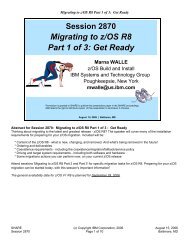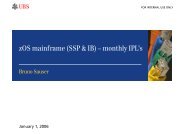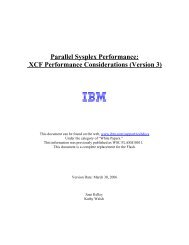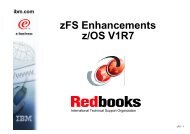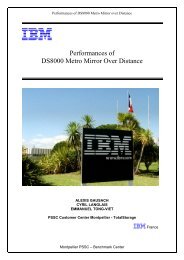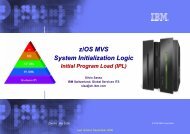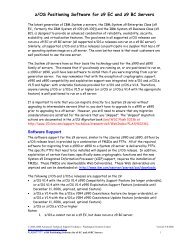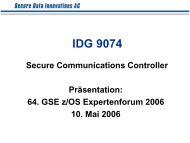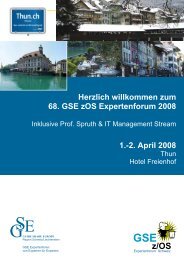Hot Topics - Messmer The Brain House
Hot Topics - Messmer The Brain House
Hot Topics - Messmer The Brain House
You also want an ePaper? Increase the reach of your titles
YUMPU automatically turns print PDFs into web optimized ePapers that Google loves.
HATS fantastic!<br />
Integrating host applications in an SOA environment<br />
BY VIKRAM GULATI<br />
In today’s mainframe and core-systems<br />
environments, applications and processes<br />
built on traditional languages, such as<br />
COBOL and PL/1, and runtimes, such as<br />
CICS and IMS, continue to deliver a wealth<br />
of mission-critical benefits to enterprises of<br />
all sizes. Many of these existing applications<br />
run on the zSeries platform and are<br />
accessible through either 3270 terminals or<br />
terminal emulation programs.<br />
<strong>The</strong>se applications and processes might<br />
be the most valuable assets an enterprise<br />
owns. After all, they do run the business.<br />
However, much of this existing technology<br />
wasn’t designed to address today’s changing<br />
market and business conditions. More<br />
and more, enterprises are realizing that<br />
to respond effectively to these changing<br />
business conditions, the existing applications<br />
need to integrate with other IT environments<br />
across the entire enterprise and across the<br />
internet with business partners, suppliers,<br />
and customers.<br />
This article explores the use of IBM<br />
WebSpere Application Server Host Access<br />
Transformation Services (HATS), which<br />
is designed to expose business logic from<br />
terminal based zSeries applications to<br />
perform a business activity. This business<br />
activity can then be integrated into a<br />
business process using WebSphere<br />
Process Server.<br />
Service Oriented Architecture<br />
overview<br />
Service Oriented Architecture (SOA)<br />
is a standards-based integration and<br />
development architecture that is independent<br />
of the differences in platforms, software<br />
architectures, languages, and network<br />
protocols. Even terminal access based<br />
applications can integrate into an SOA<br />
environment. Industry standard Web services<br />
provide a well-defined, scalable, and flexible<br />
implementation mechanism for SOA.<br />
Web services allow applications to<br />
communicate with each other in a platform<br />
and programming language-independent<br />
manner. Applications work together by<br />
exchanging service messages back and forth.<br />
SOA communication relies on open standards<br />
that include:<br />
• Simple Object Access Protocol (SOAP)<br />
• Web Services Description Language<br />
(WSDL)<br />
• Universal Description, Discovery and<br />
Integration (UDDI).<br />
Web services are designed to cut the amount<br />
of time and money needed for systems<br />
integration—the single biggest IT expense<br />
of most companies. SOA, Web services, and<br />
HATS allow you to integrate current z/OS<br />
terminal application programs into your<br />
overall business processes.<br />
HATS consists of two components:<br />
• HATS toolkit with a set of wizards and<br />
editors that create J2EE applications<br />
using the IBM Rational ® Software<br />
Development Platform<br />
• A runtime program that provides<br />
connection management—the runtime<br />
program is packaged within the J2EE<br />
application built by the toolkit.<br />
HATS macros and Integration<br />
Objects<br />
You can build Web services using HATS<br />
macros and Integration Objects. Integration<br />
Objects are JavaBeans that run HATS<br />
macros. A HATS macro is a script that<br />
defines navigations through a set of host<br />
terminal screens. Each screen in a macro<br />
includes:<br />
• A description of the screen<br />
• <strong>The</strong> actions to perform for that screen<br />
• <strong>The</strong> screen or screens that are presented<br />
after the actions are performed.<br />
For optimal performance, you can configure<br />
connection pooling plus connect and<br />
disconnect macros. A connect macro<br />
“primes” a connection in a pool by<br />
navigating to the screen at which a ‘data’<br />
macro can begin. A data macro prompts for<br />
input, navigates through the application to<br />
extract data based on the input, and then<br />
navigates back to where it can prompt for the<br />
next input.<br />
Once macros are recorded to capture the<br />
actions on the terminal screen to complete<br />
a business activity, you need to construct<br />
HATS Integration Objects using the HATS<br />
toolkit. HATS Integration Objects have input<br />
properties for all macro prompts, and output<br />
properties for all macro extracts. You can use<br />
the feature of chaining to compose one or<br />
more interactive flows through the terminal<br />
application. Integration Object chaining is<br />
necessary when a single major task can take<br />
different screen navigation paths based on<br />
programmatic decisions.<br />
HATS and Web services<br />
Once Integration Objects are created in<br />
HATS, you can use the HATS toolkit to<br />
create Web services. <strong>The</strong>se Web services<br />
provide the interface needed to invoke<br />
the business logic captured in the macros.<br />
Hence, with support for SOA in HATS,<br />
you can now extend existing terminal<br />
applications as Web services and make<br />
them “integration ready” to link to new<br />
applications. This enables “on-the-fly”<br />
integration among existing applications<br />
and across multiple business units across<br />
the enterprise. You can then link or<br />
integrate these applications into end-to-end,<br />
automated business processes — the essence<br />
of being an On Demand Business. This<br />
integration can be extended to partners,<br />
suppliers and customers to further automate<br />
business processes and drive higher<br />
productivity and efficiencies.<br />
WebSphere Business Modeler and<br />
WebSphere Integration Developer<br />
Within the context of business integration,<br />
there is a definite requirement for an<br />
integration framework that bridges the gap<br />
between the business people and the IT<br />
world. Business Process Execution Language<br />
for Web Services (BPEL4WS) fulfills this<br />
requirement by providing a<br />
standard XML language<br />
for expressing business<br />
processes consisting<br />
of functions defined<br />
through Web services<br />
interfaces.<br />
A business<br />
analyst can use<br />
WebSphere Business<br />
Modeler (WBM) to<br />
choreograph business<br />
functions into a<br />
logical process<br />
model. WBM<br />
provides<br />
February 2006 z/OS HOT TOPICS Newsletter, Issue 14 39




